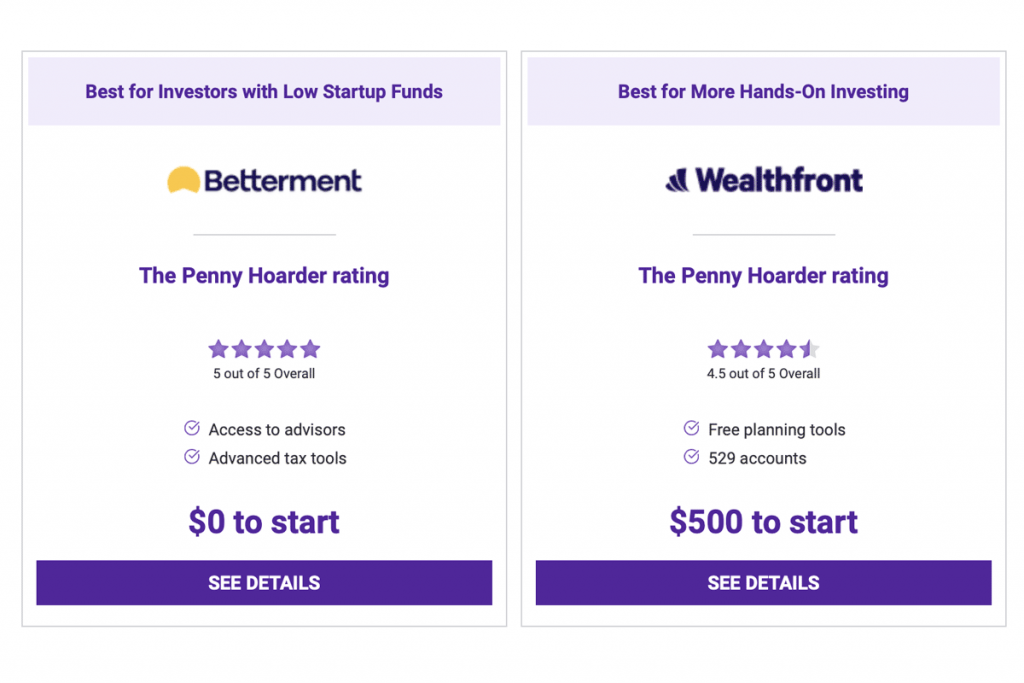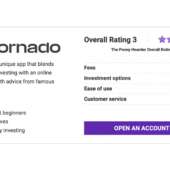Best for Investors with Low Startup Funds
The Penny Hoarder rating
$0 to start
Best for More Hands-On Investing
The Penny Hoarder rating
$500 to start
by Rachel Christian, CEPF®
Senior Writer
Betterment and Wealthfront are two of the biggest robo-advisors on the market.
They helped revolutionize the investing world with ultra-low management fees and access to customized, diversified portfolios that take the guesswork out of investing.
Both of these industry giants have expanded into full-service financial companies, offering cash management accounts, retirement accounts and financial advising tools that make it easy to bank, invest and save for retirement with a single app.
You honestly can’t go wrong with either — but these apps do differ in a few key ways.
You may spot a clear winner, depending on your investing goals and personal preferences.
In this guide, we’ll compare their similarities as well as their differences so you can pick the one that’s right for you.
Betterment vs. Wealthfront: How Do They Compare?
Both apps offer super affordable access to the market with 0.25% annual advisory fees. That’s $2.50 a year for a $1,000 account balance.
For reference, traditional brokerage firms like Edward Jones charge yearly fees of 1% or more. They usually require more cash to open an investment account, too.
And while micro-investing apps like Acorns and Stash let you start investing with just $1, you’ll pay a minimum $3 a month. For a $1,000 account balance, that’s $36 a year instead of $2.50.
Some online discount brokerage services like Robinhood don’t charge any yearly fees. But no fee means you’re stuck picking your own individual investments one-by-one and miss out on the helpful automated guidance and recommendations a robo-advisor provides.
You don’t need any money to open a Betterment investment account or cash account.
Betterment has two membership tiers:
Premium plan members pay a higher advisory fee for access to ongoing phone calls and emails with a Certified Financial Planner. These licensed financial advisors can provide more personalized advice on your portfolios, external accounts, retirement goals and other financial questions.
Digital plan members can also access personalized financial advice, but for an additional fee.
Wealthy investors get a 0.10% discount on the portion of their household balance above $2 million.
One of the biggest differences between Wealthfront and Betterment is their investment minimum.
Wealthfront requires a $500 minimum deposit to start investing. There’s a $1 minimum to open a cash management account.
After transferring $500 to open your Wealthfront account, the annual advisory fee is identical to Betterment: 0.25% of your investment portfolio balance.
Wealthfront doesn’t have a premium account like Betterment, but it does offer additional features for higher account balances, such a stock-level tax-loss harvesting for accounts over $100,000, and a Smart Beta program available to accounts over $500,000.
The only other fee you’ll encounter with Betterment or Wealthfront is ETF expense ratios.
An expense ratio shows the portion of an ETF’s funds that go toward fund management. The lower an ETF’s expense ratio, the more of your money is invested and the more you stand to earn.
You’ll pay those fund fees with any broker or robo-advisor, and the cost is quite low: Both companies carry expense ratios in the 0.08% to 0.13% range on average.
Betterment and Wealthfront give you options.
You can open a bank account, different types of investment accounts and (in Wealthfront’s case) a college savings account.
Betterment and Wealthfront both offer these financial accounts:
The only difference is Wealthfront gives users access to a 529 college savings plan and Betterment does not.
Wealthfront and Betterment will both recommend either a taxable account or a tax-advantaged individual retirement account (IRA) when you sign up. Depending on your financial goals, it might open one of each.
These recommendations are based on things like your age, risk tolerance and financial goals — information you’ll enter when you create your account.
In addition to traditional, Roth and SEP IRAs, Wealthfront and Betterment also accept IRA and 401(k) rollovers.
Both apps do a good job explaining the tax perks (and early withdrawal penalties) that come with investing in an IRA.
They also give you financial planning tools to create your own personalized retirement roadmap and track your progress.
You can also tweak the variables in your retirement plan, including your retirement age, planned savings, estimated spending and life expectancy.
Both robo-advisors offer digital banking services with no fees.
That’s right: Betterment and Wealthfront offer savings/checking accounts with no overdraft fees or minimum balances.
Other similarities between their cash accounts:
Wealthfront and Betterment will both send you debit cards when you open a checking account.
Wealthfront offers reimbursement at 19,000 ATMs, but Betterment is the clear winner on ATM fees.
Betterment’s Visa debit card reimburses all ATM fees worldwide. You’ll also skip foreign transaction fees when you use your debit card abroad.
You can start using Betterment’s banking features for free. You’ll need $1 to open a Wealthfront cash management account.
You don’t need to invest with either company to access their cash management services.
If you’re looking for a way to save money for a child’s college expenses, Wealthfront offers 529 savings plans.
A 529 college savings plan is a tax-advantaged way to save and invest for higher education costs. Investments in a 529 account grow tax-deferred and money can be withdrawn federal tax-free if it’s used to pay for qualified higher education costs.
You won’t pay any annual fees on the first $5,000 invested in a Wealthfront 529 plan. After $5,000, fees range from 0.42% to 0.46%, plus expense ratios.
A 529 plan is a unique offering, since Betterment and most other robo-advisors don’t provide this type of account.
Wealthfront and Betterment both provide access to automated portfolios with low fees and an emphasis on passive investing.
They also both follow Modern Portfolio Theory — an investment strategy that focuses on diversified asset allocation to reduce your risk and increase your returns. By spreading your dollars across different asset classes — or categories of investments — you’ll take less of a hit if any particular security nosedives.
Other similarities include:
Betterment focuses on goal-based investment strategies. It offers users a core investment portfolio consisting of stock- and bond-based exchange-traded funds (ETFs).
What is an ETF? Read our full explanation of this popular investment vehicle.
Betterment also offers a few curated investment portfolios you can choose from:
Betterment invests your money through fractional shares — tiny portions of equity that aren’t a full stock or bond. That means all your money is invested from day one. Wealthfront, in contrast, does not offer fractional share investing.
However, Wealthfront offers more opportunities for hands-on investment management than Betterment.
In 2021, Wealthfront gave users the option to add or remove specific ETFs from a recommended portfolio or build an entirely new ETF portfolio from scratch. Users also get the option to invest in portfolio themes like technology and health care.
People with $100,000 or more in their Wealthfront account can pick a stock-based portfolio instead of an ETF-based portfolio.
Wealthfront also has real estate investment trusts (REITs) along with two long-term cryptocurrency funds with exposure to Bitcoin and Ethereum. Betterment does not offer exposure to these alternative investments.
Wealthfront offers just one socially responsible portfolio instead of three, but users can customize any investment portfolio to include socially responsible options.
Automation is the beauty of robo-advisors — but what if you need someone to talk to for more personalized investment advice?
Wealthfront doesn’t offer this service to its clients.
Betterment does, but it’s not unlimited access for everyone.
Betterment Premium account users get access to human financial advisors by phone or email for free, while Betterment Digital users can book over-the-phone financial planning sessions for a relatively high one-time fee.
In other words, if you have a basic Betterment account, expect to pay between $299 and $399 for up to an hour-long call with a financial advisor.
If you have $100,000+ invested and pay the Premium tier 0.40% advisory fee, you get ongoing access to a team of Certified Financial Planners whenever you need help.
Both Betterment and Wealthfront use advanced software to minimize capital gains taxes.
Both robo-advisors perform daily tax-loss harvesting on all taxable accounts. Tax-loss harvesting is a strategy that sells underperforming assets for a loss in order to offset capital gains taxes.
Betterment gives users three additional tax management tools:
Meanwhile, Wealthfront offers a unique tax perk for investment accounts with $100,000 or more: stock-level tax-loss harvesting, also known as direct indexing.
Instead of using a single ETF to invest in U.S. stocks, Wealthfront’s direct indexing feature replicates the index funds inside your portfolio by purchasing up to 1,000 of the individual stocks held inside the fund. This makes it easier for the company to sell securities, offset gains and provide additional tax-loss harvesting opportunities.
Another Wealthfront tax feature: TurboTax users can directly import their tax-loss harvesting data by linking their Wealthfront account information.
Betterment and Wealthfront both give you access to powerful and easy-to-use online planning tools.
Both robo-advisors let you link external accounts to provide a holistic, high-level look at your entire financial picture.
You can also pick different goals, such as saving up for a home or investing for retirement.
Betterment’s tools let you see how a one-time deposit, recurring deposits and early withdrawals can impact your goals.
The company’s built-in retirement planning advice also considers different variables — including Social Security income, future spending, tax rates and inflation.
Meanwhile, Wealthfront offers a free planning tool called Path. You don’t need a Wealthfront investment account to access Path.
Like Betterment, Wealthfront analyzes your financial data to make sure you’re on track to meet your goals.
But the Path tool includes some additional neat features. For example, if you create a home buying goal, Wealthfront integrates third-party data from Redfin and Zillow to show you cost estimates based on real estate prices in your area.
Or, if you’re saving up for a child’s college expenses, Path can pull data from the Department of Education to show forecasts of tuition and cost at thousands of U.S. universities.
These robo-advisor rivals share more similarities than differences.
Here’s what sets them apart from each other.
Here are the features you’ll only find with Wealthfront.
Here’s what Betterment offers that Wealthfront doesn’t.
It’s hard to pick a clear winner.
Betterment and Wealthfront both make investing easy by offering useful features like daily tax-loss harvesting and wealth-building tools.
Key differences include the option to speak with a human advisor for higher account balances through Betterment, a 529 college saving plan option with Wealthfront and a $500 minimum difference to start investing.
Betterment is a good fit if:
Wealthfront is a good fit if:
In short, the “best” robo advisor for you depends on what you want and need from an investing app.
Rachel Christian is a Certified Educator in Personal Finance and a senior writer for The Penny Hoarder.
This article contains general information and explains options you may have, but it is not intended to be investment advice or a personal recommendation. We can’t personalize articles for our readers, so your situation may vary from the one discussed here. Please seek a licensed professional for tax advice, legal advice, financial planning advice or investment advice.
Ready to stop worrying about money?
Get the Penny Hoarder Daily
Privacy Policy
© 2021 The Penny Hoarder. – All rights reserved.
Privacy Policy and Terms of Service | Do Not Sell My Personal Information | Cookies Settings






